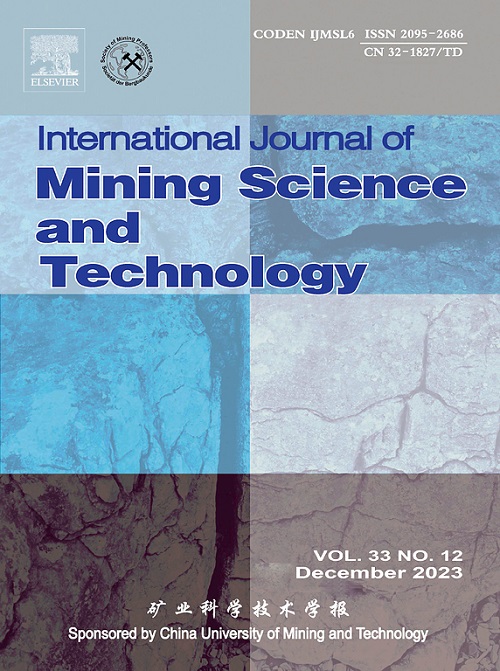Extraction of the key infrared radiation temperature features concerning stress and crack evolution of loaded rocks
IF 11.7
1区 工程技术
Q1 MINING & MINERAL PROCESSING
International Journal of Mining Science and Technology
Pub Date : 2024-08-01
DOI:10.1016/j.ijmst.2024.08.003
引用次数: 0
Abstract
The infrared radiation temperature (IRT) variation concerning stress and crack evolution of rocks is a critical focus in rock mechanics domain and engineering disaster warning. In this paper, a methodology to extract the key IRT features related to stress and crack evolution of loaded rocks is proposed. Specifically, the wavelet denoising and reconstruction in thermal image sequence (WDRTIS) method is employed to eliminate temporal noise in thermal image sequences. Subsequently, the adaptive partition temperature drift correction (APTDC) method is introduced to alleviate temperature drift. On this basis, the spatial noise correction method based on threshold segmentation and adaptive median filtering (OTSU-AMF) is proposed to extract the key IRT features associated with microcracks of loaded rocks. Following temperature drift correction, IRT provides an estimation of the thermoelastic factor in rocks, typically around 5.29×10−5 MPa−1 for sandstones. Results reveal that the high-temperature concentrated region in cumulative thermal images of crack evolution (TICE) can elucidate the spatiotemporal evolution of localized damage. Additionally, heat dissipation of crack evolution (HDCE) acquired from TICE quantifies the progressive failure process of rocks. The proposed methodology enhances the reliability of IRT monitoring results and provides an innovative approach for conducting research in rock mechanics and monitoring engineering disasters.
提取有关加载岩石应力和裂缝演变的关键红外辐射温度特征
与岩石应力和裂缝演变有关的红外辐射温度(IRT)变化是岩石力学领域和工程灾害预警的一个关键重点。本文提出了一种提取与加载岩石应力和裂缝演变相关的关键 IRT 特征的方法。具体而言,采用小波去噪和重建热图像序列(WDRTIS)方法消除热图像序列中的时间噪声。随后,引入自适应分区温度漂移校正(APTDC)方法来减轻温度漂移。在此基础上,提出了基于阈值分割和自适应中值滤波(OTSU-AMF)的空间噪声校正方法,以提取与加载岩石微裂缝相关的关键 IRT 特征。经过温度漂移校正后,IRT 可估算出岩石的热弹性系数,砂岩的热弹性系数通常约为 5.29×10-5 MPa-1。结果表明,裂缝演变累积热图像(TICE)中的高温集中区域可以阐明局部损伤的时空演变。此外,从 TICE 获取的裂纹演化热耗散(HDCE)可量化岩石的渐进破坏过程。所提出的方法提高了 IRT 监测结果的可靠性,为岩石力学研究和工程灾害监测提供了一种创新方法。
本文章由计算机程序翻译,如有差异,请以英文原文为准。
求助全文
约1分钟内获得全文
求助全文
来源期刊

International Journal of Mining Science and Technology
Earth and Planetary Sciences-Geotechnical Engineering and Engineering Geology
CiteScore
19.10
自引率
11.90%
发文量
2541
审稿时长
44 days
期刊介绍:
The International Journal of Mining Science and Technology, founded in 1990 as the Journal of China University of Mining and Technology, is a monthly English-language journal. It publishes original research papers and high-quality reviews that explore the latest advancements in theories, methodologies, and applications within the realm of mining sciences and technologies. The journal serves as an international exchange forum for readers and authors worldwide involved in mining sciences and technologies. All papers undergo a peer-review process and meticulous editing by specialists and authorities, with the entire submission-to-publication process conducted electronically.
 求助内容:
求助内容: 应助结果提醒方式:
应助结果提醒方式:


